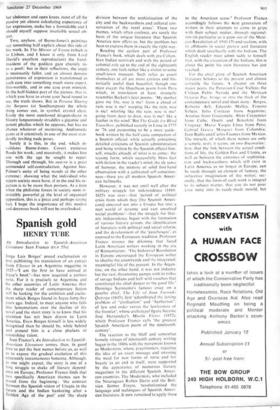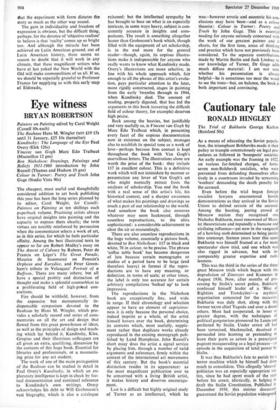Spanish gold
HENRY TUBE
An Introduction to Spanish-American Literature Jean Franco (cup 55s) Jorge Luis Borges' proud exclamation on first publishing his translation of an extract from Ulysses in an Argentine magazine in 1925-7 am the first to have arrived at Joyce's book'—has now acquired a curious twist. For it is precisely to Argentina and the other countries of Latin America that the sharp reader of contemporary fiction will be looking for the ambition and excite- ment which Borges found in Joyce forty-five years ago. Indeed, to meet anyone who falls into lamentations over the decline of the novel and the short story is to know that his attention has not been drawn to Latin America. Even Borges himself is less widely recognised than he should be, while behind and around him is a close phalanx of astonishing talent.
Jean Franco's An Introduction to Spanish- American Literature comes, then, in good time to put the best names before us, as well as to expose the gradual evolution of this apparently instantaneous bonanza. Although, as one might expect, the story is one of a long struggle to shake off literary depend- ence on Europe, Professor Franco finds that two specifically American themes can be traced from the beginning: 'the contrast between the Spanish vision of Utopia in the future and the Indian hankering after a Golden Age of the past' and 'the sharp
division between the sophistication of the city and the backwardness and cultural con- servatism of the rural areas'. These two themes, which often coalesce, are surely the basis of the unique literature that Spanish America now offers us, but the problem has been to express them in exactly the right way.
Reading the earliest part of Professor Franco's book, which deals with pre-Colum- bian Indian survivals and with the period of colonial rule up to the end of the eighteenth century, one feels rather like a visitor to some small-town museum. Such relics as assert themselves at all are more curious and his- torically useful than beautiful, though one must except the Quechuan poem from Peru which, in translation at least, strangely resembles Beckett's later poems: 'My mother gave me life, woe is me! from a cloud of rain, woe is me! weeping like the rain, woe is me! whirling like the rain, woe is me! going from door to door, woe is me! like a feather in the wind.' But The Guide for Blind Travellers, published secretly in Lima in 1775 or '76 and purporting to be a mere guide- book written by the half-caste companion of a Spanish official, while actually containing detailed criticisms of Spanish administration and being written by the Spanish official him- self, smacks already of what is to come: the teasing form, which successfully blurs fact with fiction in the reader's mind, the sly sense of humour, the mixture of solid first-hand observation with a cultivated self-conscious- ness—these are all modern Spanish Ameri- can hallmarks.
However, it was not until well after the military struggle for independence (1810- 1825) was over—that 'period of political crisis from which they [the Spanish Ameri- cans] emerged not into a Utopia but into a real world of tyranny and vast unsolved social problems'—that the struggle for liter- ary independence began with the formation of various literary groups, the identification of literature with political and social reform, and the development of the `gauchesque, as opposed to the European. tradition. Professor Franco stresses the dilemma that faced Latin American writers working in the era of Romanticism: 'The Industrial Revolution in Europe encouraged the European writer to idealise the countryside and the integrated, meaningful life of the peasant. In the Argen- tine, on the other hand, it was not industry but the vast, threatening pampa with its tribes of savage Indians and half-wild gauchos that constituted the chief danger to the good life.' Domingo Sarmiento's famous essay on a gaucho chief, The Life of Juan Facundo Quiroga (1845), first 'adumbrated the lasting problem of "civilisation" and "barbarism"; of law and order versus the lawlessness of the frontier', whose archetypal figure became Jose Hernandez's Martin Fierro (1872), which Professor Franco calls 'the greatest Spanish American poem of the nineteenth century'. The reaction to the bluff and somewhat homely virtues of nineteenth century writing began in the 1880s with the movement known as Modernism, whose practitioners, rejecting the idea of an overt message and stressing the need for new forms of verse and for beauty as an end in itself, were supported by the appearance of numerous literary magazines in the different Spanish Ameri- can countries. The Modernists, who included the Nicaraguan Ruben Dario and the Boli- vian Jaimes Freyre, 'revolutionised the language and techniques of Spanish Ameri- can literature. It now remained to apply these to the American scene.' Professor Franco accordingly follows the next generation of writers in their attempts to come to grips with their subject matter, through regional- ism (in particular as it grew out of the Mexi- can Revolution of 1910-171 and realism, with its offshoots in social protest and literature which dealt specifically with the Indians. The English reader must admit sadly to himself that, with the exception of the Indians, this is about the point his own literature has just reached.
For the chief glory of Spanish American literature belongs to the present and almost certainly the future. A chapter on three major poets, the Peruvian Cesar Vallejo, the Chilean Pablo Neruda and the Mexican Octavio Paz. brings us into the thick of the contemporary novel and short story: Borges, Roberto Arlt, Eduardo Mallea, Ernesto Sabato. Julio Cortizar from Argentina; Asturias from Guatemala; Alejo Carpentier from Cuba; Onetti and Benedetti from Uruguay; Mario Vargas Llosa from Peru; Gabriel Garcia Marquez from Columbia; Juan Rulfo and Carlos Fuentes from Mexico. The miracle, of which these names are only a sample, rests, it seems, on two discoveries: first, that the link between the actual condi- tions of life, the Golden Past and Utopia, as well as between the extremes of sophistica- tion and backwardness which still exist in Latin America as no longer in Europe, can be made through an element of fantasy, the subjective imagination of the writer; sec- ondly, that the form of each work is integral to its subject matter, that you do not pour your story into its ready-made mould, but
that the experiment with form dictates the story as much as the other way round.
The gain in individuality and freedom of expression is obvious, but the difficult thing, perhaps, for the devotee of 'objective realism' to believe is that 'reality' comes up so bright too. And although the miracle has been achieved on Latin American ground, out of Latin American history, there seems no reason to doubt that it will work in any climate, that these magnificent writers who have at last yoked the New World with the Old will make cosmopolitans of us all. If so, we should be especially grateful to Professor Franco for supplying us with this early map of Eldorado,















































 Previous page
Previous page